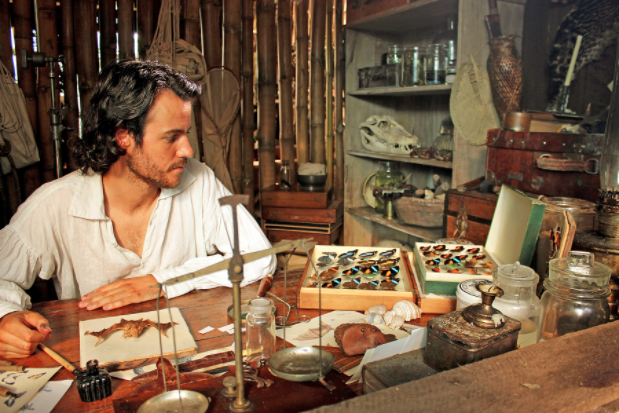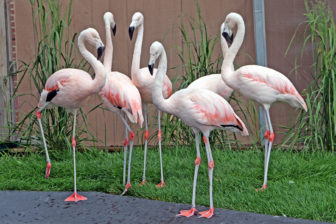Plunge deep into the Brazilian rain forest for a giant-screen journey of discovery among glimmering butterflies, surprising insects and a prowling jaguar in the new IMAX movie “Amazon Adventure,” opening July 1 at The Maritime Aquarium at Norwalk.
The compelling story of 19th-century scientific breakthrough will play at 11 a.m. and 4 p.m. daily through Labor Day in Connecticut’s largest IMAX Theater, with a screen that’s six stories high.
____________
— an announcement from the Maritime Aquarium
____________
“Amazon Adventure” recounts the extraordinary work of naturalist Henry Bates, who the filmmakers call “the most influential scientist you’ve never heard of.”

From the movie: Henry Bates, 19th century Amazon adventurer
Beginning in 1848, Bates risked his life for science during an 11-year expedition into the Amazon rain forest, and his findings provided “the beautiful proof” for Charles Darwin’s then-controversial theory of natural selection, the scientific explanation for the development of life on Earth.
Filmed in the lush Amazon region, with scenes of sloths, brilliantly colored birds and amazingly camouflaged insects and lizards, “Amazon Adventure” lets audiences join Bates as he searches for clues about how and why species – particularly butterflies – change and adapt over time.
“I saw strange creatures that hide in plain sight by looking like something completely different,” Bates (played by Calum Finlay) says in the film. “A ‘leaf’ that flies. ‘Bird droppings’ that walk. … A ‘flower bud,’ whose nectar attracts a bee, is really a spider. So with your disguise, you get eaten less and get to eat more, a double advantage.”
Bates discovered more than 8,000 species new to science. His collections demonstrated that species do adapt, thus supporting Darwin’s theory and disproving the then-common belief that “species were divinely created in their current form, that they never changed, and never would.”
No, No — Not THAT Amazon Movie
In April, The Lost City of Z — a DIFFERENT movie about a DIFFERENT English explorer going up the Amazon — was in theaters. This is not that movie. (And the Amazons in the Wonder Woman movie have nothing to do with this, either, but you knew that.)
Painstakingly researched for three years, “Amazon Adventure” enlisted the expertise of more than 100 scientists and historical advisors.

Contributed photo
An Amazon plant
The team’s commitment to authenticity not only resulted in this rigorous re-creation, even using actual instruments and tools from the 1850s, but the writing team also incorporated many of Bates’ own words, as he was a gifted storyteller.
“From a humble background, with an unstoppable passion for science and life, Bates played guitar, had a pet monkey, relied on Amazonian natives to survive and learned many of their languages, and made crucial contributions to our understanding of the natural world,” said Jonathan Barker, CEO of SK Films and one of the movie’s executive producers.
“He should be more widely known and we’re thrilled to introduce his remarkable story to the public.”

Contributed photo
Henry Bates, recording for science
Developed and produced in close collaboration with HHMI Tangled Bank Studios, “Amazon Adventure” also received major funding from the National Science Foundation through the film’s educational outreach partner, Pacific Science Center.
Other key partners include the Gordon and Betty Moore Foundation, the Simons Foundation, and Foxconn Brazil and Vale.

Contributed photo
Dialogue not in the movie: “By the bends in the river.” “You mean the BEND in the river.” “Oh, just wait — you’ll see.”
A co-production between Canada, the U.K. and Brazil, the production was granted unprecedented access by the Natural History Museum of London to film Bates’ own scientific field notebooks and botanical drawings, and to film the butterflies he personally collected over 160 years ago.
“Walking in the footsteps of Henry Walter Bates, audiences get to follow the clues and see one of the most important discoveries about life unfold before them, scene by scene,” said Sean B. Carroll of HHMI Tangled Bank Studios and the film’s other executive producer.

Photo from Maritime Aquarium / Maritime Aquarium
There are actually flamingos along the Amazon. If you see the movie, you can also see these Chilean flamingos in person at the Maritime Aquarium, and it costs a lot less to do both than to fly down to South America.
“Through Bates’ eyes, we see some of the first and best evidence of how and why species evolve. We hope this film, in tracing his adventures in the Amazon, shows where curiosity and perseverance can lead and inspires younger and older viewers alike.”
Of the movie, Variety magazine said: “While nearly all made-for-IMAX educational movies boast breathtaking visuals, this one matches its imagery with an equally memorable story.”
The film is 44 minutes long, and is a great South American-themed pairing with the Chilean flamingos on special exhibit for the summer at The Maritime Aquarium — the only place to see flamingos in Connecticut this summer.
Also showing daily in The Maritime Aquarium’s IMAX Theater from July 1-Labor Day are “Secret Ocean” (noon & 3 p.m.), “National Parks Adventure” (1 p.m.) and “Dream Big” (2 p.m.).
One IMAX movie – and the flamingos exhibit – are included with paid Maritime Aquarium admission: $22.95 for adults; $20.95 for youths (13-17) and seniors (65+); and $15.95 for children (3-12). Kids under 3, and Aquarium members, are admitted for free.
Reserve your tickets, view a trailer of “Amazon Adventure,” and get more details — including a link to the film’s educational content — at the Maritime Aquarium website.
